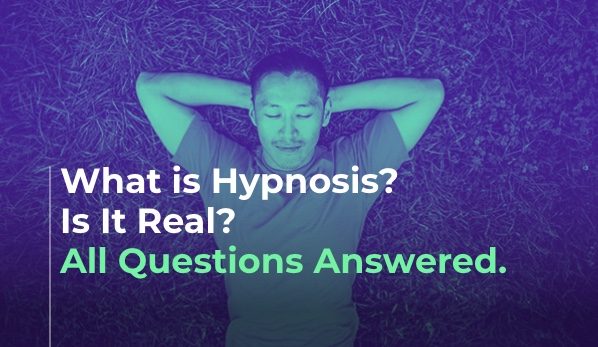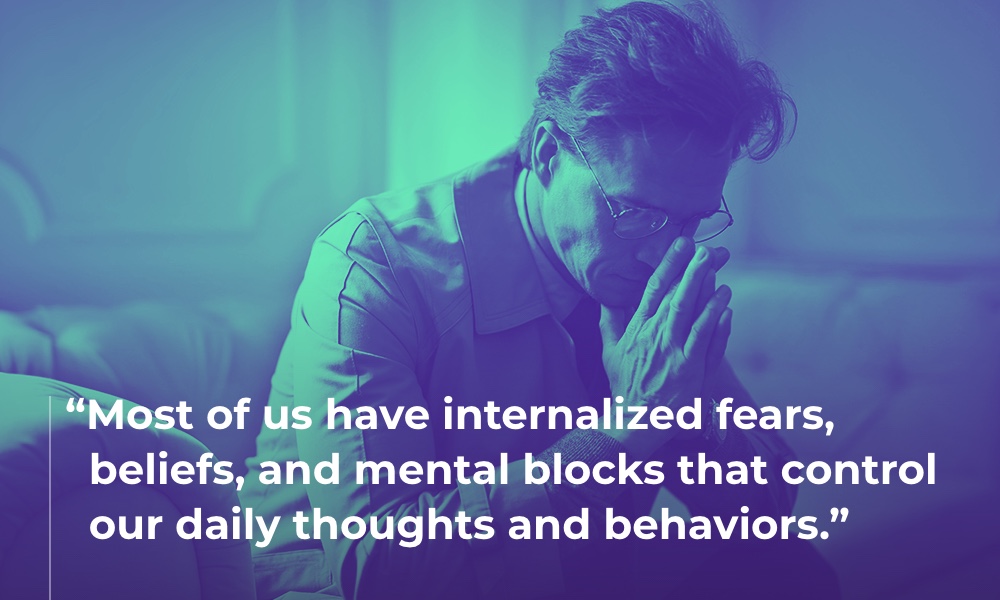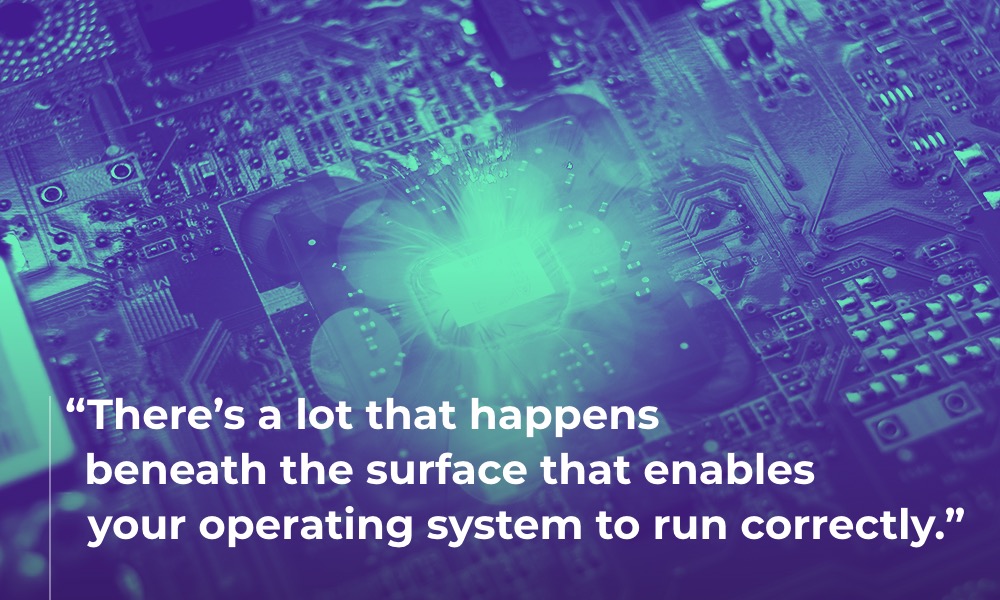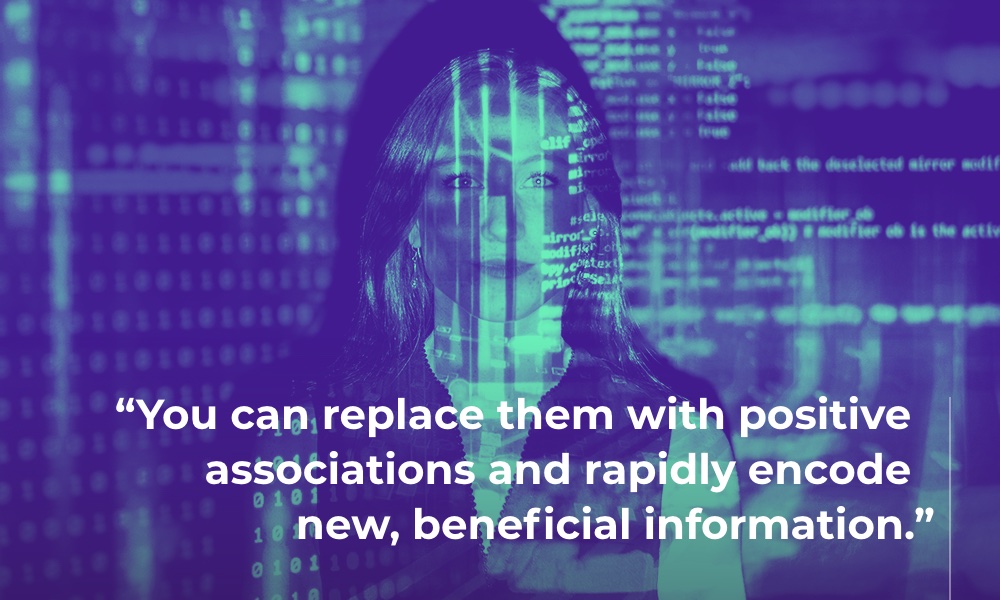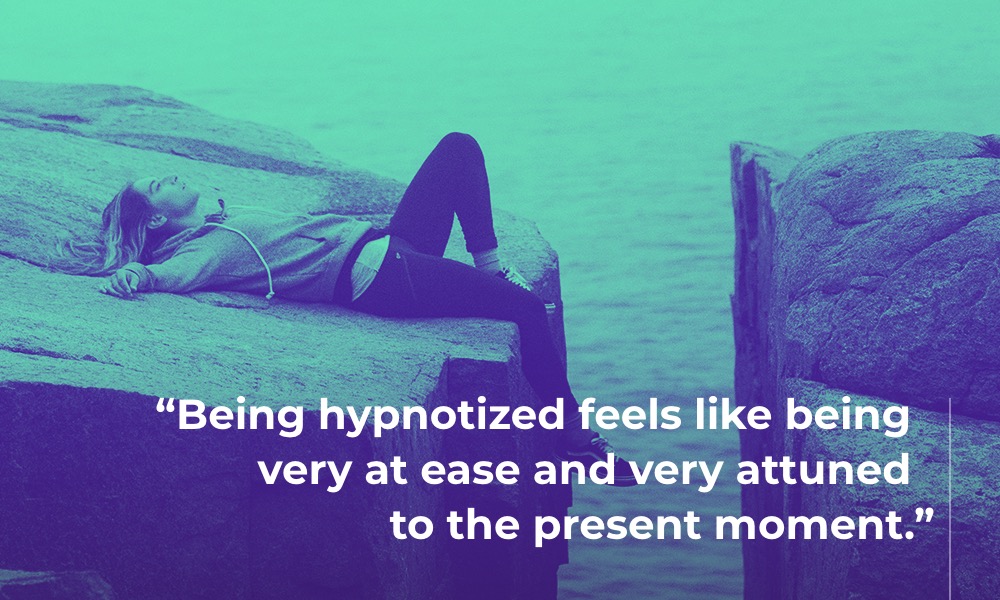No matter how much success you’ve found in life, you likely haven’t reached your full potential. Chances are there’s still at least one thing holding you back from being the best possible version of yourself.
Maybe you get all your work done, but you find yourself procrastinating every step of the way. Or maybe you know the life you want to live, but you lack the focus or self-esteem to actually achieve it.
Or, let’s say you’ve worked your way up to your dream job, but the stress of work gives you low-quality sleep. Or perhaps you have the family you’ve always wanted, but you find yourself overeating late at night after the kids have gone to bed. Maybe you’ve reached all of your current goals, but anxiety prevents you from enjoying what you’ve achieved.
These struggles (and many more) are extremely common—and they also have a common root: the subconscious mind. Deep in our subconscious, most of us have internalized fears, beliefs, and mental blocks that control our daily thoughts and behaviors more than we realize. While some people may use other methods to identify and alter these subconscious thoughts, many people need to go deep into the mind with hypnosis to truly address and change the thoughts.
This is difficult to do in your everyday mental state because your conscious mind is calling the shots. But when you put the conscious mind on pause and enter a deeply relaxed state, that’s when real change can happen. So how do you get there? The answer is hypnosis. The idea of hypnosis can seem intimidating, but there’s nothing to fear. In fact, it’s a lot like watching your favorite movie.
What is Hypnosis?
Hypnosis is a state of extreme relaxation and heightened suggestibility.
Believe it or not, hypnosis is a familiar feeling. Some scientists state that any time you’re engrossed in a film, captivated by a book, or “in the zone” while working on a project, you’re in a state of hypnosis.
Of course, the type of hypnosis we’re discussing today isn’t the kind that happens at the movie theater. Instead, we’re talking about the kind of hypnosis that can create lasting behavioral change and help you actualize your deepest desires. And for this, you’ll need to work with a hypnotherapist or use a hypnosis app, like Primed Mind.
What Is Hypnosis Used For?
Hypnosis is used to help address medical issues, break addictions, and obliterate mental roadblocks. It’s used in a wide range of healthcare specialties, including:
- Insomnia or trouble sleeping
- Chronic pain
- Mental health conditions
- Addictions to drugs and alcohol
- Side effects from cancer treatment
- Irritable Bowel Syndrome (IBS)
It’s also been proven to:
- Improve self-esteem and self-confidence
- Break bad habits like procrastination
- Increase motivation and concentration
- Reduce worry and stress levels
- Improve mental and physical performance
- Enhance memory and creativity
Hypnosis gives you the ability to stop self-sabotaging, so you can act in your own best interest. It can help you gain control of goals you’re having a hard time with, like smoking cessation or stopping overeating. Plus, it can also cultivate positive traits, like confidence and self-esteem. It helps you actualize your goals, break through the mental blocks holding you back, and drive you towards success.
Many of the world’s leading mindset coaches, clinicians, and health professionals find great success incorporating hypnosis into their practices. If you think you don’t know of anyone who’s undergone hypnosis, think again. People like Julia Roberts, Albert Einstein, Tiger Woods, Thomas Edison, and Michael Jordan—to name just a few—have all made use of hypnosis.
Types of Hypnosis
There are a few different ways to enjoy the benefits of hypnosis. We’ll go over a little bit about each below.
Hypnotherapy
Hypnotherapy is just what it sounds like: hypnosis administered to you by a hypnotherapist. (This may also include clinical hypnosis in a medical setting.) In a standard session, a hypnotherapist leads you into a hypnotic state.
Once you’re in the hypnotic trance, the trained practitioner uses techniques, like suggestion and regression hypnotherapy. These techniques help you break through mental blocks in your subconscious, creating positive changes in your everyday life.
Most people are hypnotizable, and many people find success with this option. However, they may eventually find that going into a hypnotherapist’s office is too costly or time consuming (or both). At this point, they may transition to self-hypnosis or guided hypnosis.
Self-Hypnosis
The truth is, all hypnosis is self-hypnosis. Even when you’re working with a hypnotherapist, or using a guided hypnosis app, you are the one creating the mental state you’re in. Someone can help guide you into this state, but it’s not something someone can do to you.
That means self-hypnosis is a great option for small mindset changes. But it’s a lot more difficult to use self-hypnosis to identify mental blocks or deeply rooted beliefs. For that, it’s best to work with a trained practitioner.
Guided Hypnosis
With guided hypnosis, you use pre-recorded audio tracks to enter a hypnotic state. You can find these on a hypnosis app.
Primed Mind is a hypnosis app that uses audio primers that prepare the conscious and subconscious minds to be more receptive to new suggestions. The app uses hypnotherapy techniques, like suggestion and visualization, to help you create positive behavioral patterns and encourage change in your life.
Try a Guided Hypnosis Session
If you’d like to try a guided hypnosis session, check out our primer on unshakeable confidence!
How Does Hypnosis Work?
To understand how hypnosis works, we first need to explore the functions of the conscious and subconscious minds.
Your conscious mind is the one that’s aware of what you’re doing, using logic and reason to make decisions. You tend to live your everyday life in your conscious mind, fully aware of your actions. If you’re into computers, you might think of the conscious mind as your brain’s operating system. But there’s a lot that happens beneath the surface that enables your operating system to run correctly.
Your subconscious mind, on the other hand, is the underlying code that powers the operating system. It’s the 1s and 0s that you only get a glimpse of when the computer is booting up, but it’s the foundation that the whole device is built upon. Your subconscious is the part of your brain that encompasses everything you’ve ever seen, done, thought, or known. And it contains all of the filters you use to make your daily decisions. In order for your conscious mind to work efficiently, the subconscious mind makes decisions on autopilot—without you even realizing it.
This is fine, until you develop a fear or bad habit that negatively impacts your life. These unwanted thoughts and behaviors get hardwired into your subconscious mind. However, your conscious mind actively works against you altering anything in your subconscious, because even if they’re unhelpful, these thoughts have been your coping mechanisms. And this is where hypnosis comes in. With hypnosis, you can go deep into the code and reprogram it so your operating system is running exactly how you want it to.
Using Hypnosis to Reach the Subconscious
Hypnosis works by helping you relax into a state of mind where your subconscious can take over. In this state, it’s easier to identify and change the subtle beliefs controlling your behaviors. When you’re in a hypnotized state, you’re extremely receptive to helpful suggestions. These suggestions were made to help you thrive in specific aspects of your life, and you can effortlessly act upon them once your session is complete.
There are many hypnosis techniques, such as regression, visualization, and suggestion. But suggestion-based hypnotherapy is by far the most popular. Let’s take a look at how hypnotic suggestion works.
Exploring Hypnotic Suggestion
During a hypnotic suggestion session, your hypnotist or hypnosis app brings your subconscious to the surface. Your guide then makes suggestions that help you address your specific concerns. Here’s what a typical session may look like:
Hypnotic Induction
Phase 1 is often called the hypnotic induction phase. In this phase, your hypnotist or app leads you into a state of intense relaxation. The goal is for your subconscious—your brain’s coding system, to follow our computer example—to take over. Your hypnotist might reach your subconscious through a combination of techniques, like muscle relaxation, counting, using metaphors, and music. Most people find this to be a very relaxing process! Your hypnotist or app will gradually deepen this hypnotic trance state until you’re ready for phase 2.
Hypnotic State
In phase 2, you’re in the hypnotic state, and you’re ready to receive suggestions. Here, your conscious mind drops down its guard. Although you’re in a state of deep relaxation here, it’s important to note that you’re not actually asleep or unconscious. Quite the opposite, in fact. You’re so focused that you’re tuning out all of the external stimuli around you. You’re fully in the present moment.
In this state, your mind thinks creatively and allows for instant breakthroughs. You internalize any helpful suggestions much more deeply than you would in your typical conscious state. You’re able to work with your long-term memory and reframe your triggers to break bad habits and release unhelpful thought patterns. You can replace them with positive associations and rapidly encode new, beneficial information.
In phase 2, your hypnotist also makes suggestions about how to feel during your hypnosis session. For example, they may tell you to feel your relaxation double with each breath you take. Or, they may make suggestions for how you’ll feel after the session. For example, “I easily and effortlessly communicate in social situations.” The former is called a hypnotic suggestion, and the latter is called a post-hypnotic suggestion.
Brought out of Hypnotic State
In phase 3, you’re gently brought out of your hypnosis session with techniques like music and counting. Typically, you feel relaxed, recharged, and ready to tackle your goals as you exit your hypnosis session.
Other Hypnosis Techniques
Depending on the type of hypnotherapy, your hypnotist or app may use visualization, a technique that uses mental images to change your mindset and behavior.
Or, they might use modeling, in which you’re asked to envision either a role model or an ideal version of yourself.
You mirror their body language, posture, values, beliefs, actions, and behaviors.
Your hypnosis session might include anchoring, in which you learn to “switch on” feelings you want to experience, like calm or confidence. To do this, your hypnosis guide will help you anchor your desired feeling to a certain stimulus (like a sound or smell) that you can invoke whenever you need it.
Similarly, you may have anchors that you don’t wish to have, like having a beer when we get home from work.
Hypnosis can help you remove these.
The Science Behind Hypnosis and Its Benefits
There are some who claim that hypnosis is nothing but the placebo effect, but that’s not true. Hypnosis is recognized by the American Psychological Association (APA) as a credible form of therapy because it actually works. And there’s a lot of science that backs it up. First, let’s look at how hypnosis works. Then, we’ll see the scientific studies that support its results.
The Neuroscience of Hypnosis
A 2016 Stanford Study demonstrated that hypnosis actually modifies activity in certain parts of the brain responsible for processing and filtering information. The study’s senior author, David Spiegel, and his team studied people’s brains while under hypnosis. They discovered three significant findings:
First, they found that during a hypnosis session, the activity decreases in the part of your brain that processes incoming information (the dorsal anterior cingulate). This allows the subconscious to take over.
Second, they saw an increased connection between the brain’s executive control network (the dorsolateral prefrontal cortex) and the part of the brain that controls the body (the insula). This is the mind-body connection.
The increased activity under hypnosis allows you to adopt new information at a complex intellectual level and a core functional level, too.
Finally, they found that a hypnosis session temporarily lessens the connection between your brain’s executive control network and your default mode network. This allows you to bypass the limiting, structured thought patterns that keep you stuck.
The Proven Benefits of Hypnosis
There are a lot of studies that support the benefits of hypnosis. This is because hypnosis can help with whatever your goals are. By activating the subconscious mind and making changes at the core level of your being, hypnosis has been proven to aid in:
- Falling asleep more quickly (and getting better quality sleep)
- Reducing stress and anxiety levels (including before medical procedures)
- Calming fears
- Improving self-esteem
- Having better control over your mindset
- Focusing better
And because hypnosis strengthens your mind-body connection, it’s also used to address a range of health conditions including (but not limited to):
- Irritable bowel syndrome (IBS)
- Hot flashes
- Pain Management (even pain during childbirth)
- Depression
Could You Benefit From Hypnosis?
Chances are, yes, you could benefit from hypnosis. While there are many ways hypnosis could help you, many of them can be broadly labeled as helping you get “unstuck.” In other words, hypnosis helps you move out of the habit, addiction, belief system, or thought pattern that’s keeping you gridlocked somewhere you don’t want to be.
Hypnosis is a great option to try if you:
- Want to unlock your maximum amount of potential
- Feel a deep sense of frustration that you’re not achieving your goals, despite putting in maximum effort
- Generally feel stuck and unmotivated to achieve your biggest goals
- Struggle with mental fog or a chronic lack of focus
- Suffer from repetitive negative thoughts and emotions
- Encounter paralyzing fear that stops you from getting what you want out of life
- Find that you sabotage your own success, even in ways you don’t fully understand.
Many people turn to hypnosis because they’ve had limited success with other methods to change their thoughts and behaviors. Many people who use psychotherapy, psychiatry, psychoanalysis, and other forms of talk therapy find that hypnosis is the perfect complementary add-on to their practice that helps unlock big changes.
Common Myths About Hypnosis
Just as pop culture often exaggerates other types of therapy, hypnotism also has a mainstream reputation that isn’t entirely accurate. In a professional hypnosis session, there are no waving pocket watches and you certainly won’t be made to cluck like a chicken!
Let’s address some other common misconceptions:
Myth #1: Hypnosis Can Make You Do Things Against Your Will
Hypnosis cannot make you do things against your will. When you’re undergoing a hypnosis session, your conscious mind is fully aware of all suggestions you hear. You cannot do, believe, or say anything that you do not fully intend to adopt in your life. You have complete control over every part of the process.
Myth #2: You Can Get Stuck in a Hypnotized State
It’s a common fear that if you allow yourself to become hypnotized, you’ll be unable to return to an everyday waking state of consciousness. But you shouldn’t worry. It is not possible to get “stuck” in a state of hypnosis. You always return to full waking awareness, just like you would from a daydream.
Myth #3: Some People Can’t Be Hypnotized
Hypnosis is a natural state, just like a deep meditation. And just like a meditative state, it may be easier for some people to reach a hypnotized state than others. But that doesn’t mean it’s not available to everyone. While it’s true that different people respond to hypnosis differently, virtually everyone has the ability to be hypnotized and benefit from hypnosis.
Frequently Asked Questions About Hypnosis
If you’re new to hypnosis, it’s natural to have a lot of questions. We’ll go over a few of the most common ones below, so you can feel prepared for your first session.
What Does Being Hypnotized Feel Like?
Being hypnotized feels like being very at ease and very attuned to the present moment. You’re focused on your hypnotist or app, and you’re not distracted by the constant commentary of your conscious mind. Instead, you’re focused within, aware, relaxed, and tuning out external stimuli. In this way, it’s very much like being absorbed in a good book or movie. It can also feel like daydreaming. The majority of people find hypnotism to be a relaxing restorative experience.
Can You Be Hypnotized to Not Feel Pain?
Hypnosis is not a medical treatment that removes pain. However, because hypnotism temporarily affects your mind-body connection, it can help with pain management. In other words, while it won’t cure the source of your pain, hypnotism can help with pain control by altering your experience of pain.
Can You Hypnotize Someone to Do Anything?
Hypnotism is not a method for controlling other people. In order for the person being hypnotized to act on a suggestion that’s made to them, they must be willing to do it. Hypnosis requires consent in order to work. When someone consents to the suggestions made during a hypnosis session, the suggestions can have an enormous, positive impact on their well-being.
Using Primed Mind for Hypnosis at Home
Primed Mind is a hypnosis app that allows you to experience the benefits of hypnosis at the touch of a button. That means you can fit hypnosis into your wellness schedule, and you can do it at home, at the office, or wherever you happen to be.
Our app helps you unlock your full potential by showing you how to tap into powerful areas of your mind. You’ll be able to break through roadblocks, visualize goals, and reach success, all from your smartphone or tablet.
By downloading Primed Mind for free, you’ll learn how to overcome fear, boost confidence, reduce stress levels, and get better sleep. Primed Mind can help you even if you feel you’ve been performing at less than your best for far too long.
How Does Primed Mind Work?
Primed Mind uses hypnotic primers. They’re designed to improve your performance in the areas of your life that are most important to you. Most sessions last between 5 and 20 minutes and are created by one of the world’s leading hypnotherapists and mindset and performance coaches.
These hypnosis audio primers are designed to prepare the conscious and subconscious mind to be more receptive to new suggestions. Our professional hypnotherapists set up the correct internal environment for you to have the most effective and beneficial hypnosis experience. And they gently guide you through the rest of your session, focusing on your specific goal.
The app uses some of the hypnotherapy techniques we spoke about earlier—like suggestion and visualization—to help you create positive behavioral patterns and encourage change in your life. Through our sessions, you’ll adopt positive daily habits, accelerate at work or school, transform your social life, and achieve major personal goals—all through the power of hypnosis.
You can pick a one-off hypnosis session like “Start Your Day Right” or take on some of our 7-day courses like “Building Better Habits” or “Improving Sleep Quality.” Or peruse our library of free audio sessions to help you find the topics most suitable for you. We have topics based on specific mindset goals and any challenges you’re currently experiencing.
Navigate the through our easy-to-use dashboard and use a wide range of features designed to close the gap between potential and performance. We’ve also collaborated with some incredible athletes and subject matter experts to create a series of professional content to help you reach your next level of success.
How to Get the Most Out of Primed Mind
Like we discussed earlier, you must consent to hypnosis for it to work, and so your success with any type of hypnosis session depends on your desire to change. In other words, if you’re thinking of trying hypnosis to change a behavior that—at your core—you are not ready to change, then hypnosis probably won’t work for you right now.
However, if you’re ready to take the leap, make a change, and transform your life into something you’re truly proud of, this is the option that can finally deliver the results you’ve been hoping for.
Download Primed Mind today and prime your mind for success!

